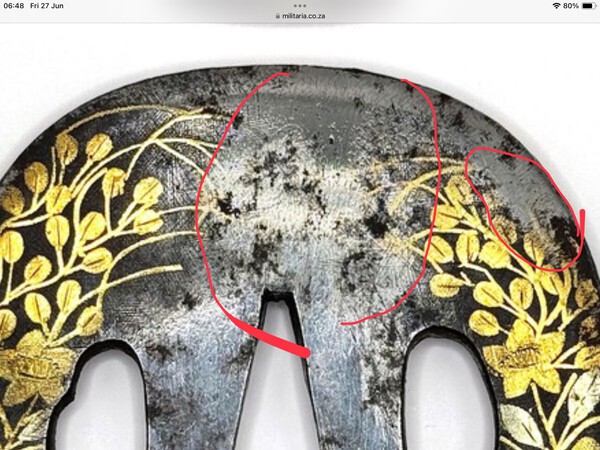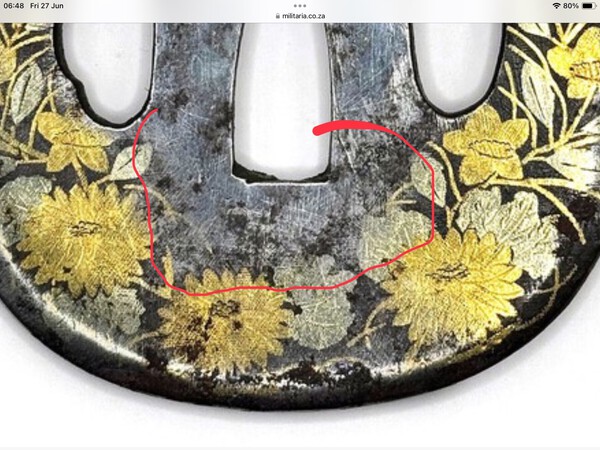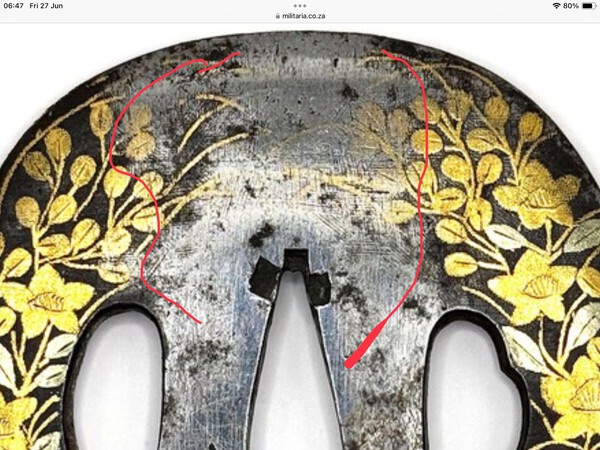
Matsunoki
Gold Tier-
Posts
3,419 -
Joined
-
Last visited
-
Days Won
63
Content Type
Profiles
Forums
Events
Store
Downloads
Gallery
Everything posted by Matsunoki
-
Trouble is we are not part of EU now so bringing anything in using any method attracts customs duties even from Europe …..that then brings into question having to prove the age etc. Antique is 5% but otherwise it’s 20%…..and in my experience they apply 20% and it’s up to you to prove otherwise. Also if you risk it by not declaring it and get caught it’s probably bye bye sword. Alex is right re his views on this country…..so disappointing and depressing.
-
We’ll to my (old) eyes the iron surface AND the nunome has been very heavily abraded…..see circled areas in red. The nunome has virtually disappeared and where it remains it is very weak. Also imo the Japanese would never put silver nunome onto a silver(ed) surface…..what would be the point? It would not show up. Not the sort of artistic blunder that the Japanese would ever make. Also imo we can see the remains of deep pitting in several areas especially where the surface has been abraded suggesting very nasty corrosion had existed. Also, in areas where there is no abrasion to the plate or the nunome the surface colour does not suggest tarnished silver, it looks exactly as it should ie patinated iron. Im not trying to score points but if someone is spending substantial money on these things it is useful to understand what we are looking at…..and why it looks as it does….and best not to rely on what any Auctioneer says.
-
I’m struggling to believe this is silvered. The silver colour looks like heavily worn shiny iron ie it has lost all of it original dark patina. Personally I’ve never ever seen nunome zogan on silver or on silver plate. In this case the silver nunome would not have stood out against the background? To my eyes it is a heavily abraded and worn iron plate that just happens to look like it’s been silvered. I hope i am wrong because that’s a hell of a price for a worn iron tsuba.
-
The two overlapping plaques remind me of those that are found on Torii at Shrine entrances…..try putting an image on the translation section. eg…
-
Ian, have you got images of the whole tsuba?
-
Be a bit clearer and tell us why.
-
Help please on tsuba box inscriptions
Matsunoki replied to Matsunoki's topic in Translation Assistance
@Nobody Moriyama san, very kind of you. Many thanks. Best. C. -
Lovely to see such skill. You should be very proud. Congrats.
-
Help please on tsuba box inscriptions
Matsunoki replied to Matsunoki's topic in Translation Assistance
-
Please can you tell me what this all says on a tsuba box? Many thanks in advance….and apologies for all the shadows.
-
From these images it simply isn’t possible to tell you the age with any confidence. Read what Ray said…..that’s the opinion of a real expert and it’s the best you’ll get. Elsewhere you might get other opinions but that’s all they’ll be…opinions. The blade is in such rough shape that absolutely no detail is visible.
-
Well now we know! An old Tanto blade repurposed. Interesting and it has its own place in history. Possibly used as a multi-purpose tool rather than a gardening tool (wrong shape for that). Also, the saya is far too long and too curved to have been made for this blade so maybe it’s a marriage between an old blade and an existing mounting.
-
Hi Piers, this item is also being discussed in this thread…… Always confusing when we get two threads going on the same item…. Best.C.
-
Please show both sides of the complete nakago ie including the machi area and the jiri. From what you have shown so far the Mei is in a totally inappropriate place on the nakago and thus highly unlikely it was put there by whoever made the blade. The nakago patina suggests that it is suriage and machiokuri ie the nakago has been chopped and the machi moved up the blade.
-
Looks like a heavily abused old Nihonto blade to me. edit……. with a spurious Mei added in an implausible place on a nakago that has been heavily “modified”
-
Did he say exactly how he deduced that?
-
My money is still on re-cycled Japanese blade…..which indeed the Ainu did which makes perfect sense -so the blade could well be that old. However no way the mounts are 4-500 years old (imo)
-
Fake, as I said on your other post. Why post twice?
-
@Bugyotsuji Piers, I was not ignoring your ceramic netsuke……it’s just that I know nothing about them and have never even handled one. As you suggest, many (most?) have not survived to tell their tale. They do have a charm all of their own though.
-
Sorry to say this is not a legit netsuke. It is a low quality “look alike” intended for the modern market. Probably not carved in Japan.You can see the dragons scales have been fashioned using a rotary tool eg a dremmel with a small round burr rather than a sharp blade or graver. It lacks artistry and refinement. I believe this is what Piers aptly describes as a “netsuke like object”. Apologies for disappointment…..but I suspect you suspected.
-
Then we will never know.
-
If you take the peg out does the hilt come off? If so image of tang? Its possible it could be a very poor condition Tanto blade in “home made” mounts. Cant be sure from these pics.
-
Your suspicions are correct. Late Meiji period intended for the enthusiastic foreigners that were around at the time. It looks as if the tsuka and saya are clad in thin pressed sheets of a base metal which would have been brightly gilded/multipatinated at the time thereby giving an impression of some quality. The blades are often just plain unforged steel. I believe the metal used for the mounts is a pewter type alloy. Apologies for any disappointment.












